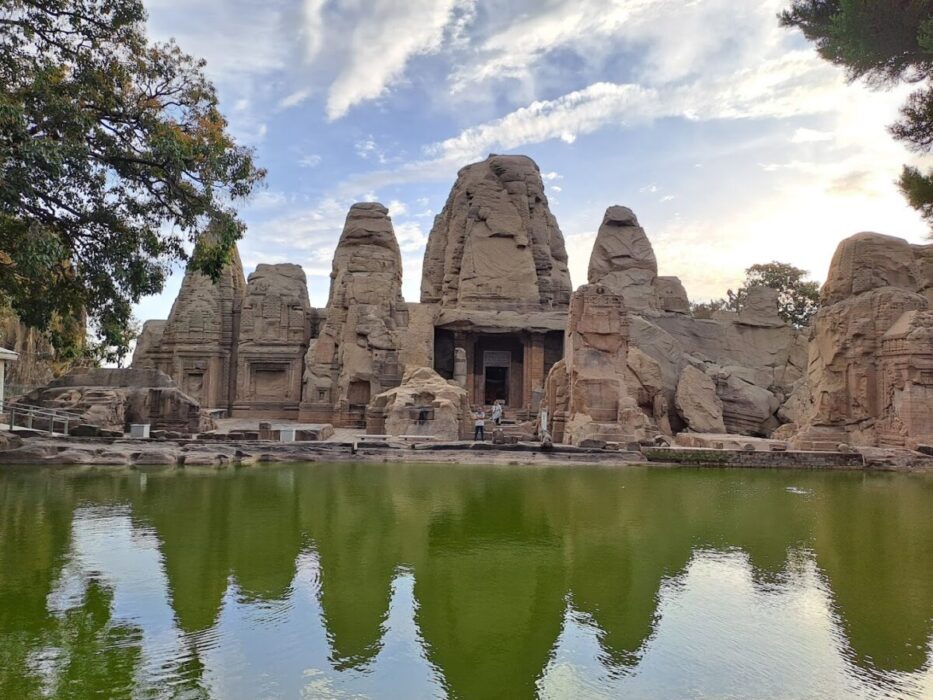History Of Masroor Rock Cut Temple
The Masroor Temples, also known as the Rock-cut Temples at Masroor, stand as an early 8th-century marvel of rock-cut Hindu architecture located in the Kangra Valley of Himachal Pradesh, India. Facing northeast towards the Dhauladhar range, these temples represent the Nagara architectural style of North India. Masroor Rock Cut Temple honors Hindu deities like Shiva, Vishnu, Devi, and Saura.
While a significant complex, archaeological studies reveal the artists’ and architects’ grander vision, suggesting an incomplete project. Sadly, much of the temple’s sculptures and reliefs have been lost or damaged, likely due to earthquakes over time.
Carved from the monolithic rock with shikhara, the temples boast three entrances, though one remains largely unfinished.The layout adheres to a symmetrical mandala pattern, with the main sanctum encircled by smaller shrines.Intricate reliefs depict Vedic and Puranic deities, narrating Hindu legends.
Discovered in 1913 by Henry Shuttleworth and surveyed by Harold Hargreaves in 1915, these temples represent a unique blend of Hindu temple architecture and mountain symbolism, as noted by art historian Michael Meister.
When to go to Masroor Temple?
Travelers can visit the temples starting from 7 a.m.to 7 p.m., but it’s wise to avoid the monsoon season due to potential landslide risks from heavy rainfall. For an immersive cultural experience, timing your visit around Shivratri adds vibrancy to your exploration, complementing the temple’s allure.
The Masroor Rock Cut Temple, situated in Dharamshala, Himachal Pradesh, India, offers the most delightful experience from October to April. During these months, Dharamshala enjoys pleasant weather with minimal rainfall, perfect for exploring the temples and surroundings. Temperatures range from a comfortable 14°C to 28°C, ensuring visitors can appreciate the intricate carvings and architecture without weather-related discomfort. Moreover, the post-monsoon period enhances the lush greenery, providing a stunning backdrop to the temple complex.
Travelers may find October, November, and early spring (March to April) particularly appealing, as the weather is mild, and the region is less crowded, offering a serene experience. Aligning your visit with local festivals like Navratri and Dussehra adds to the cultural richness of Himachal Pradesh. Despite favorable climatic conditions, checking the weather forecast beforehand is advisable, and carrying light woolens for chilly evenings is recommended.
Places To Visit In & Around
- Key tourist attractions near the Masroor Temple Complex include the following:
- Hotspring, Tatpan is located 24 km away.
- Kangra Fort and Museum (an archaeological site) are approximately 34 km away.
- Gupt Ganga Temple, situated 5 km from Kangra Fort.
- Raja Sansar Chandra Museum and Cafe is about 35 km away.
- Wildlife Sanctuary: Found 14 km from the temple complex.
- Dharamshala is Located at a distance of 40 km.
- Dip Tse Chok Ling Monastery is Only 300 m from McLeodganj Bus Stand and 9 km from Dharamshala.
- State War Memorial is approximately 39 km away.
- The Tibet Museum is located 45 km away.
- About 49 kilometers separate St. John in the Wilderness from the temple complex.
- Dainkund Peak is situated 125 km away.
- Namgyal Monastery is located approximately 45 km away.
- Tsuglagkhang Complex Dalai Lama Temple is located 45 km away.
How to Get To Road
Thankfully, the Masroor temple is located on the Nagrota-Surian Road, just minutes from Kangra. Using a taxi or private vehicle on this route is easy. A clean and tidy highway connects Dharamsala to Pathankot, and regular bus services go along this route, giving visitors greater options to move.
Train
Travelers can decide to take a train to the next train station, Pathankot railway station, which is located around 87 kilometers from Dharamsala, to travel to Masroor Temple. Although there aren’t any direct trains to Masroor Temple, Pathankot railway station is a handy hub for transportation. Travelers can continue their trip to Masroor Temple from Pathankot by bus or taxi. Kangra Railway Station is also connected. Joginder Nagar via a narrow gauge train from Pathankot, offering another transportation option for travelers.
Air
To access Masroor Rock-cut temple, travelers can utilize Gaggal Airport, located just 15 km away from Dharamshala. This airport offers frequent flights to and from Delhi, ensuring convenient connectivity. Travelers arriving at Gaggal Airport have the option to either drive themselves or hire a taxi to reach the revered ancient temple site.
Also Read 8 Must-Visit Historical Places In Himachal Pradesh
Conclusion
The Masroor Rock-cut Temple Complex is a testament to the beauty of old design, drawing visitors from all over the world who are impressed by its exquisite carvings and historical significance. Located in the beautiful hills of Dharamshala, this historical symbol offers a window into the rich cultural legacy of Himachal Pradesh and an entry point to explore the neighboring attractions, including monasteries, wildlife sanctuaries, and Kangra Fort. History buffs, culture vultures, and environment fans all stand to gain a unique experience from a visit to Masroor Temple, whether it’s because of its serene atmosphere, religious importance, or architectural magnificence.








